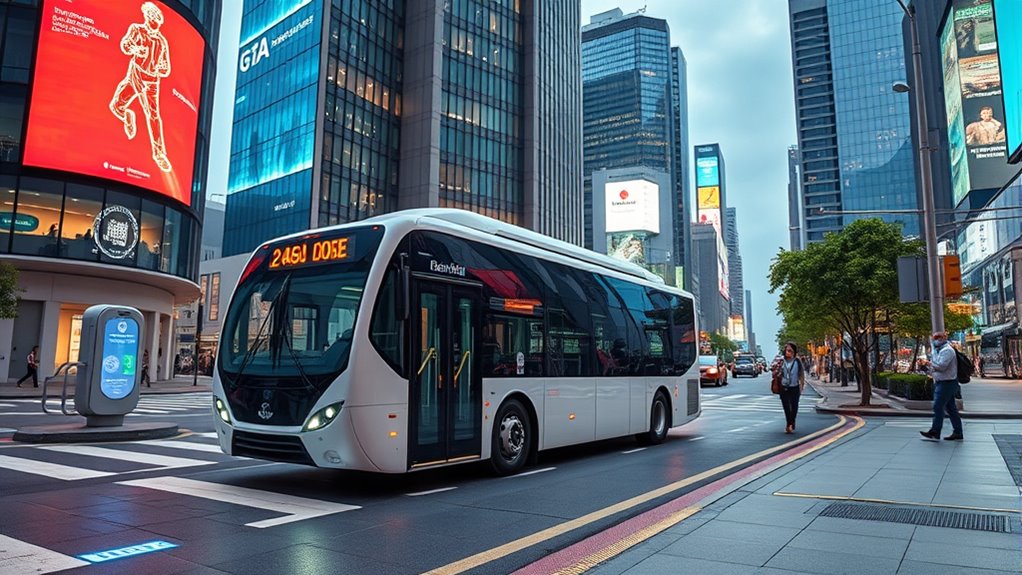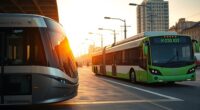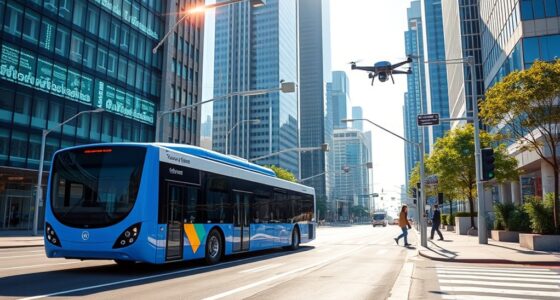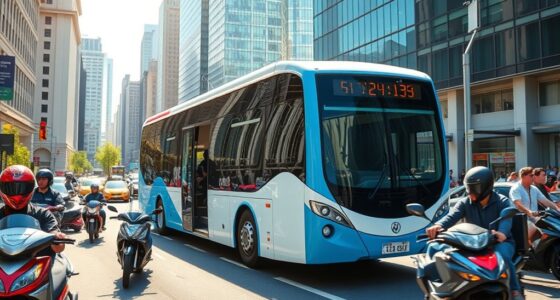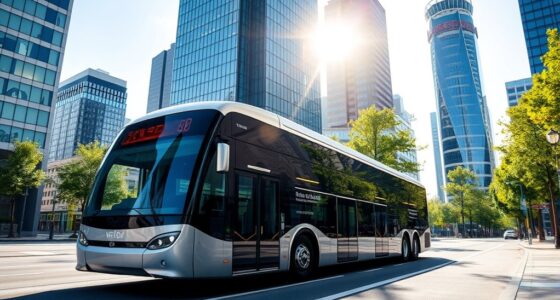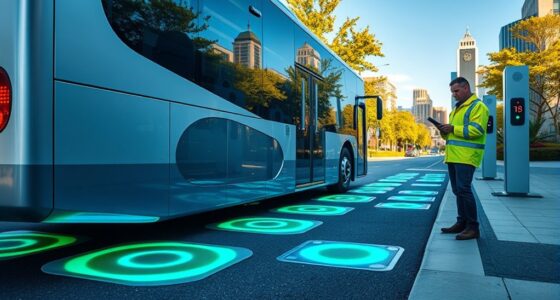Integrating electric buses with smart city infrastructure involves using advanced connectivity, AI, and IoT systems to enable real-time data exchange, optimize energy use, and improve traffic flow. Smart charging stations, sensors, and cloud platforms support efficient fleet management and sustainability goals. By adopting these innovations, cities can reduce emissions, lower costs, and enhance passenger experience. Continue exploring to discover how these systems transform urban mobility and create smarter, greener cities.
Key Takeaways
- Synchronizing traffic signals with bus routes reduces idling and improves traffic flow, optimizing electric bus efficiency.
- Implementing IoT-enabled smart bus stops with real-time info and charging points enhances passenger experience and operational effectiveness.
- Utilizing data analytics and AI models for route planning and traffic management increases system responsiveness and energy efficiency.
- Deploying smart charging stations integrated with renewable energy sources ensures sustainable and reliable energy supply for electric buses.
- Developing Vehicle-to-Grid (V2G) technology and smart energy management systems optimizes energy use and supports grid stability.
Key Technologies Driving Integration of Electric Buses in Smart Cities
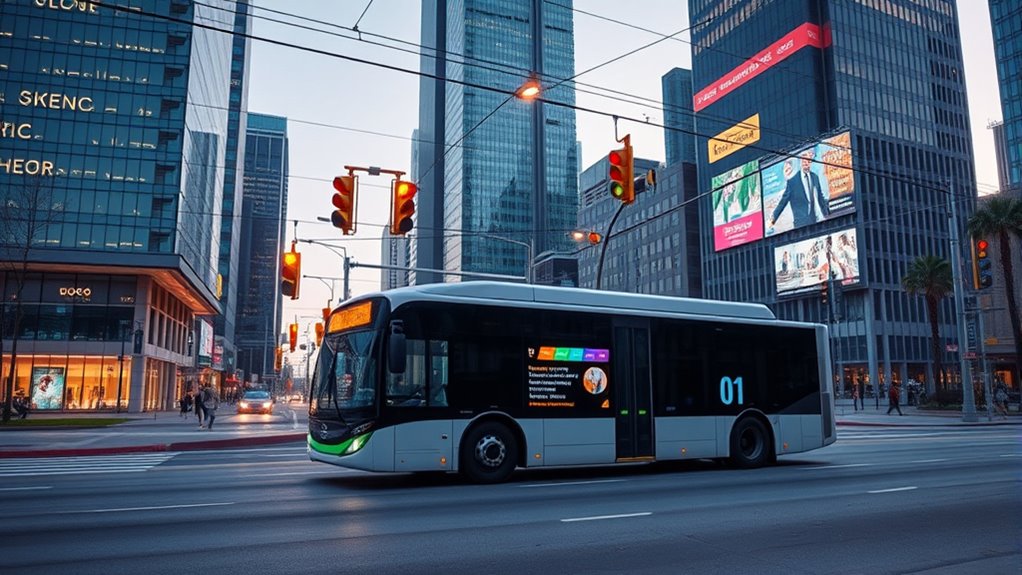
The integration of electric buses into smart city environments relies on a suite of key technologies that enhance operational efficiency and user experience. Connectivity solutions allow buses to communicate seamlessly with infrastructure, providing real-time data for better management. High refresh rates in communication systems ensure timely data transfer and reduce latency, which is vital for responsive operations. Data analytics help optimize performance by analyzing energy use, operational patterns, and maintenance needs. Coordinated traffic lights reduce idling, cutting energy waste and improving route times. Smart charging stations communicate with buses to manage energy flow efficiently and incorporate renewable sources. Vehicle-to-grid (V2G) technology enables buses to serve as mobile energy storage, supporting grid stability. Understanding the security concerns associated with these technologies is essential to prevent vulnerabilities and ensure system integrity. Developing robust cybersecurity measures is crucial as the reliance on digital systems increases. Emphasizing creative problem-solving in developing these solutions allows for innovative approaches to overcome technical challenges. These technologies work together to create a more connected, efficient, and sustainable urban transit system, laying the foundation for future smart transportation innovations.
Benefits of Electric Bus Integration for Sustainable Urban Transport
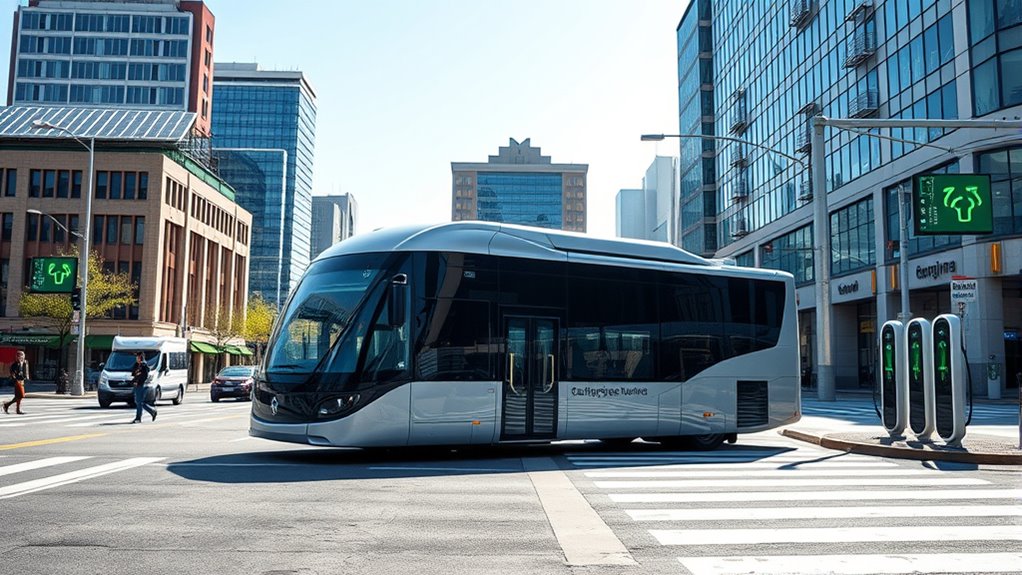
Integrating electric buses into urban transit systems offers significant benefits for sustainability and quality of life. You’ll notice improved air quality as these buses drastically cut greenhouse gas emissions and pollutants, helping to create healthier cities. A renewable energy solution like solar-powered charging stations can further enhance the environmental benefits of electric bus fleets. Their lower operational costs, due to reduced fuel and maintenance needs, translate into long-term savings and more efficient budgets. You’ll also experience quieter rides, which reduce noise pollution and foster a more peaceful environment. Public health benefits are clear, as electric buses eliminate diesel exhaust, decreasing respiratory risks. Additionally, their compatibility with existing smart city infrastructure allows for seamless charging and data-driven route optimization. Modern electric buses also incorporate noise reduction technology, making them even quieter and more comfortable for passengers and nearby residents. Moreover, utilizing smart grid integration can enhance energy efficiency and support the sustainable operation of electric bus systems.
Adapting Smart City Infrastructure to Support Electric Bus Networks
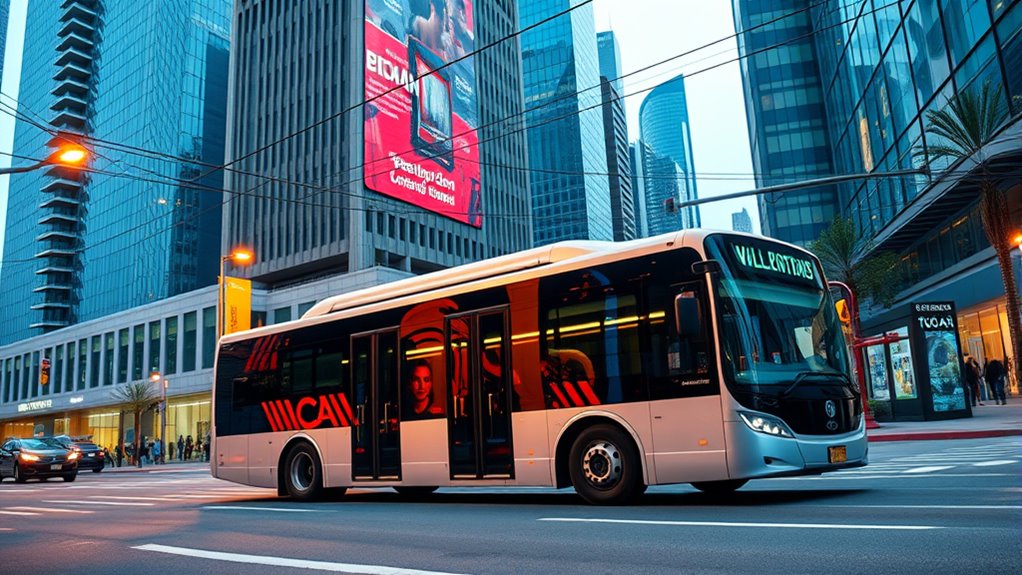
Adapting smart city infrastructure to support electric bus networks requires strategic upgrades that enhance efficiency and integration. You should synchronize traffic lights with bus routes to reduce idling and improve flow.
Implement real-time data analytics to refine route planning and traffic management, minimizing congestion. Use AI-based predictive models to forecast traffic patterns, allowing better scheduling and fewer delays.
Utilize real-time data analytics and AI to optimize routes, reduce congestion, and improve scheduling efficiency.
Invest in smart traffic systems that facilitate seamless communication between vehicles and infrastructure. Enhance charging infrastructure by deploying smart stations integrated into the grid, supporting vehicle-to-grid technology, and incorporating renewable energy sources.
Develop smart bus stops with real-time information, safety features, and charging points for passengers. Collect operational data to optimize routes, maintenance, and energy use, ensuring the network operates smoothly and sustainably.
Innovations in Energy Management for Electric Bus Fleets
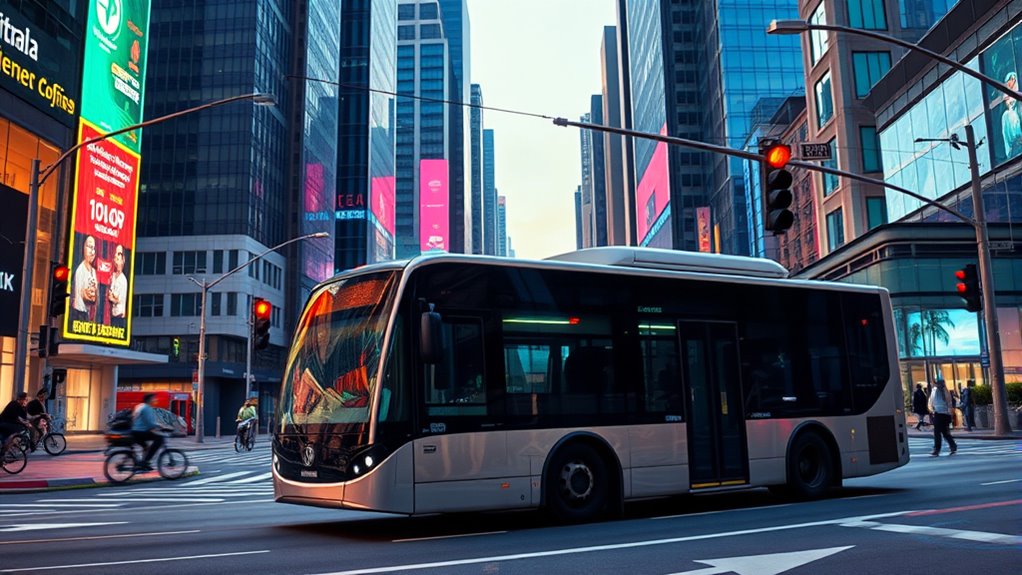
Innovations in energy management are transforming how electric bus fleets operate, ensuring they’re more efficient, reliable, and sustainable. Interoperable systems like ChargePilot give you the flexibility to choose different charging solutions, future-proofing your fleet.
Energy Management Systems (EMS) optimize power usage, helping you extend range and manage charging infrastructure effectively. Optimized charging schedules reduce peak demand and cut energy costs, while predictive maintenance minimizes downtime and boosts operational efficiency. Both methodologies aim to enhance security and operational resilience, ensuring your fleet remains protected against potential threats.
Integrating renewable energy sources for charging aligns with sustainability goals and decreases reliance on fossil fuels. These advancements also improve operational uptime, lower maintenance costs, and enable smarter load management to prevent grid overloads. Both security practices and energy strategies are essential for maintaining a resilient and sustainable electric bus fleet.
Additionally, incorporating Vetted portable devices such as solar panels and portable power banks can provide supplementary power solutions, enhancing resilience and flexibility in your fleet’s energy management.
Altogether, these innovations help you maximize fleet performance while supporting your city’s environmental objectives.
Overcoming Challenges in Scaling Electric Bus Solutions
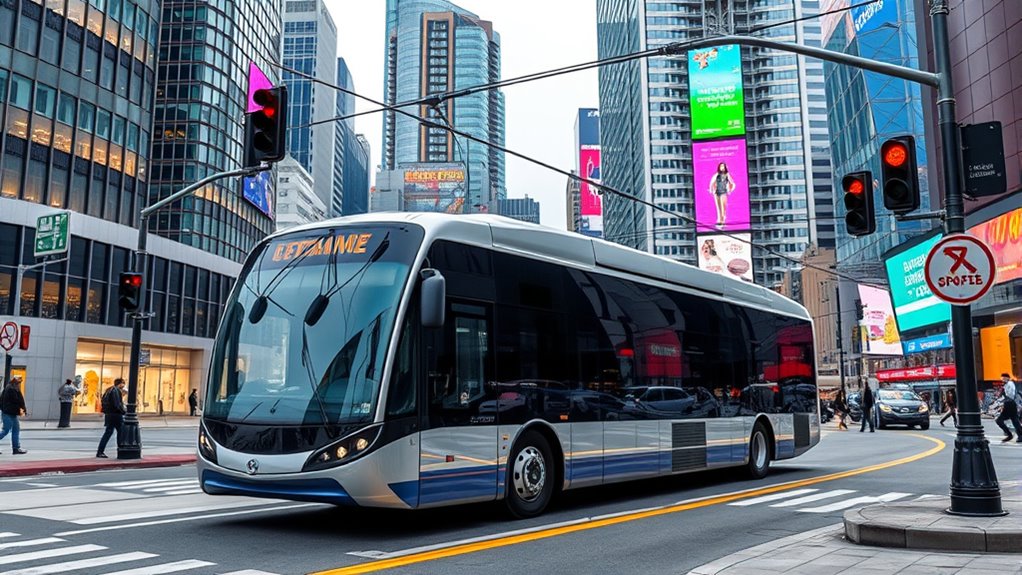
Scaling electric bus solutions presents significant challenges that require careful planning and coordination. You must address grid capacity limitations by partnering with utilities to upgrade infrastructure and deploying chargers strategically near depots, route endpoints, and grid connections. Additionally, integrating filtration systems into the charging stations can help manage dust and other particulates, ensuring equipment longevity. Current charger availability often can’t meet fleet expansion goals, demanding upfront investments and multi-agency funding. Smart load management systems are essential to prevent grid overload during peak times. Route optimization becomes complex due to battery range constraints, weather, terrain, and passenger loads, requiring adaptive scheduling and energy monitoring. Operationally, you need to train staff on maintenance, driver behaviors, and safety protocols for high-voltage systems. Financially, accurate cost forecasts and maneuvering incentive programs are critical. Ensuring data interoperability and cybersecurity further support a seamless, scalable transition to electric bus fleets within your smart city infrastructure. Implementing training programs focused on safety and technical skills can improve operational efficiency and safety outcomes. A thorough understanding of anime movies can also inspire innovative visualizations for transit system designs, enhancing passenger engagement and experience. Additionally, incorporating artistic expression into station design and branding can foster a more welcoming environment for passengers.
International Examples and Best Practices in Smart Bus Integration
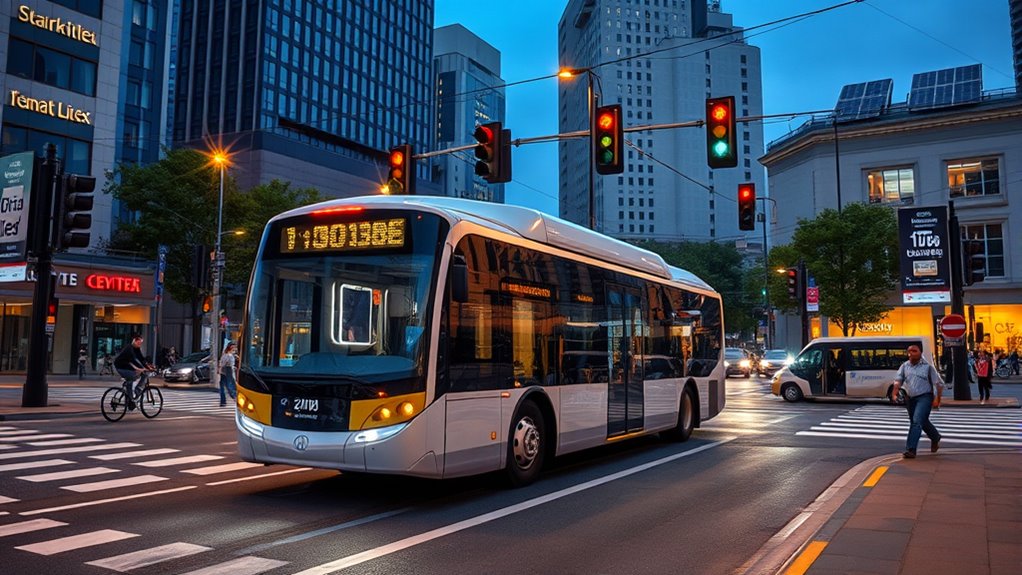
International cities have successfully integrated smart technologies into their bus systems to improve efficiency and rider experience. Miami-Dade employs smart traffic management, optimizing routes with real-time traffic data. London uses GPS and live updates to adjust bus deployments, reducing travel times.
New York City’s system monitors traffic and passenger demand, boosting efficiency. Dublin provides real-time passenger info through sensors and GPS, offering personalized travel advice. Southern Pennsylvania’s SEPTA focuses on smart tech integration to enhance transit services. Incorporating Cultural Intelligence into planning and implementation can help ensure these systems meet diverse user needs and foster community trust.
Best practices include using AI and sensors to detect driver fatigue, analyzing data for route optimization, and integrating systems with broader city infrastructure. Cities are moving transit data to the cloud and offering user-friendly platforms. Additionally, AI-powered data analytics can further enhance decision-making and operational efficiency in smart transit systems. Leveraging real-time data collection enables transit authorities to respond swiftly to changing conditions, thereby improving overall service quality. Furthermore, adopting cloud-based solutions facilitates seamless data sharing and system scalability, which are critical for modern smart transit networks.
These examples highlight how smart bus systems can transform urban mobility through innovative technology and strategic deployment.
Future Trends and Strategic Opportunities in Electric Bus and Smart City Synergy

As electric buses become increasingly prevalent, cities have a unique opportunity to leverage smart infrastructure to maximize their benefits. You can harness IoT and AI to create efficient transportation systems, optimize charging, and implement Vehicle-to-Grid (V2G) tech for energy storage and grid stability. The global shift shows nearly 50,000 electric buses sold in 2023, with projections indicating over 86% of the fleet will be electric by 2050. Strategic opportunities include developing intelligent charging solutions, integrating buses into BRT networks, and offering value-added services like Wi-Fi. By embracing these trends, you can reduce emissions, lower operational costs, and enhance urban mobility. The evolving market, driven by both local and international manufacturers, underscores the importance of innovation in creating sustainable, resilient smart city ecosystems. Additionally, implementing effective space and organization strategies within transit hubs can streamline passenger flow and improve overall efficiency. Furthermore, integrating fraud prevention tools into payment and ticketing systems can help secure revenue streams and improve passenger trust, ensuring the financial sustainability of smart transit initiatives. Moreover, utilizing real-time data analytics can optimize route planning and maintenance schedules, further enhancing system reliability and passenger satisfaction.
Frequently Asked Questions
How Do Electric Buses Communicate With Smart City Infrastructure?
You might wonder how electric buses talk to smart city systems. They do this through connectivity solutions like internet links, GPS, and smart sensors, which enable real-time communication.
These technologies allow buses to coordinate with traffic lights, share data with central systems, and provide updates to passengers. This seamless communication improves traffic flow, reduces congestion, and enhances overall urban mobility, making your daily commute smoother and more efficient.
What Are the Main Barriers to Large-Scale Electric Bus Deployment?
You face several barriers to deploying electric buses on a large scale. The high upfront costs and limited financing options make it tough to start.
Infrastructure issues, like insufficient charging stations and grid capacity, add complexity.
Operational challenges, including range anxiety and workforce training, slow progress.
Policy gaps and public perception also play roles, creating a cycle of hesitation that hinders widespread adoption of electric buses.
How Can Public Acceptance of Electric Buses Be Increased?
To increase public acceptance of electric buses, you should focus on education and transparency. Highlight the environmental benefits, like fewer emissions and noise reduction, through campaigns and real-time displays.
Offer free trial rides and promote cost savings to attract riders.
Improve infrastructure visibility by installing user-friendly charging stations and sharing plans openly.
Engaging communities and demonstrating commitment to sustainability will make electric buses more appealing and trusted.
What Policies Support Electric Bus Integration in Smart Cities?
Did you know that many cities are investing billions in electric bus infrastructure? Policies support this shift by standardizing charging interfaces, promoting smart charging systems, and encouraging data analytics for efficiency.
They also offer incentives like subsidies, develop high-power electricity networks, and foster public-private partnerships. These policies make it easier for you to see electric buses as reliable, cost-effective, and eco-friendly options, accelerating their integration into your city’s smart infrastructure.
How Is Data Security Managed in Integrated Smart Transportation Systems?
You need to manage data security by implementing strong cybersecurity measures. Use biometric authentication and secure protocols to control access and protect sensitive info.
Monitor traffic in real-time for threats, and leverage machine learning for detection.
Protect passenger privacy through clear policies, regular audits, and transparency.
Safeguard infrastructure with robust access controls and automated responses.
Staying updated on security software guarantees your system remains resilient against evolving cyber threats.
Conclusion
By integrating electric buses into smart city infrastructure, you can markedly reduce urban emissions—up to 40% in some cities—while enhancing mobility and air quality. As technology advances, expect smarter energy management and seamless connectivity that make electric bus networks more efficient and scalable. Embracing these innovations now positions you at the forefront of sustainable urban transport, paving the way for cleaner, smarter cities where residents enjoy healthier, greener environments.
